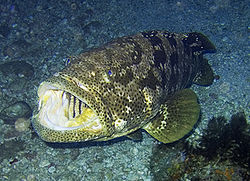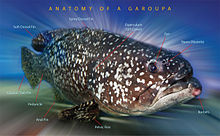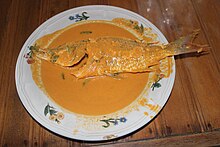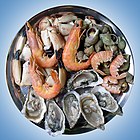Grouper
| Groupers | |
|---|---|
 | |
Malabar grouper, Epinephelus malabaricus | |
Scientific classification | |
| Kingdom: | Animalia |
| Phylum: | Chordata |
| Class: | Actinopterygii |
| Order: | Perciformes |
| Family: | Serranidae |
| Subfamily: | Epinephelinae |
| Genera | |
| |
Groupers are fish of any of a number of genera in the subfamily Epinephelinae of the family Serranidae, in the order Perciformes.
Not all serranids are called groupers; the family also includes the sea basses. The common name grouper is usually given to fish in one of two large genera: Epinephelus and Mycteroperca. In addition, the species classified in the small genera Anyperidon, Cromileptes, Dermatolepis, Gracila, Saloptia, and Triso are also called groupers. Fish in the genus Plectropomus are referred to as coralgroupers. These genera are all classified in the subfamily Epiphelinae. However, some of the hamlets (genus Alphestes), the hinds (genus Cephalopholis), the lyretails (genus Variola) and some other small genera (Gonioplectrus, Niphon, Paranthias) are also in this subfamily, and occasional species in other serranid genera have common names involving the word "grouper". Nonetheless, the word "grouper" on its own is usually taken as meaning the subfamily Epinephelinae.
Contents
1 Description
2 Systematics
2.1 Etymology
2.2 Genus
3 Reproduction
4 Parasites
5 Modern use
6 Size
7 Cultural references
8 See also
9 References
10 External links
Description

Anatomy of a grouper
Groupers are teleosts, typically having a stout body and a large mouth. They are not built for long-distance, fast swimming. They can be quite large, and lengths over a meter and weights up to 100 kg are not uncommon,[citation needed] though obviously in such a large group, species vary considerably. They swallow prey rather than biting pieces off it. They do not have many teeth on the edges of their jaws, but they have heavy crushing tooth plates inside the pharynx. They habitually eat fish, octopuses, and crustaceans. Some species prefer to ambush their prey, while other species are active predators. Reports of fatal attacks on humans by the largest species, the giant grouper (Epinephelus lanceolatus) are unconfirmed.[1]
Their mouths and gills form a powerful sucking system that sucks their prey in from a distance. They also use their mouths to dig into sand to form their shelters under big rocks, jetting it out through their gills.
Research indicates roving coralgroupers (Plectropomus pessuliferus) sometimes cooperate with giant morays in hunting.[2]
Systematics
Etymology
The word "grouper" is from the Portuguese name, garoupa. The origin of this name in Portuguese is believed to be from an indigenous South American language.[3][4]
In Australia, "groper" is used instead of "grouper" for several species, such as the Queensland grouper (Epinephelus lanceolatus). In the Philippines, it is named lapu-lapu in Luzon, while in the Visayas and Mindanao it goes by the name pugapo.[citation needed] In New Zealand, "groper" refers to a type of wreckfish, Polyprion oxygeneios, which goes by the Māori name hāpuku.[5] In the Middle East, the fish is known as hammour, and is widely eaten, especially in the Persian Gulf region.[6][7]
Genus
| Image | Genus | Common Name | Number of Living Species |
|---|---|---|---|
 | Alphestes | 3 | |
 | Anyperodon | slender grouper | 1 |
 | Aethaloperca | Redmouth grouper | 1 |
 | Cephalopholis | Maples | 25 |
 | Cromileptes | Humpback grouper | 1 |
 | Dermatolepis | 2 | |
 | Epinephelus | 89 | |
| Gonioplectrus | Spanish flag | 1 | |
 | Gracila | Masked Grouper | 1 |
 | Hyporthodus | 14 | |
 | Mycteroperca | 15 | |
 | Paranthias | 2 | |
 | Plectropomus | 7 | |
| Saloptia | 1 | ||
| Triso | 1 | ||
 | Variola | 2 |
Reproduction
Groupers are mostly monandric protogynous hermaphrodites, i.e. they mature only as females and have the ability to change sex after sexual maturity.[8][9] Some species of groupers grow about a kilogram per year and are generally adolescent until they reach three kilograms, when they become female. The largest males often control harems containing three to 15 females.[8][10] Groupers often pair spawn, which enables large males to competitively exclude smaller males from reproducing.[8][11][12][13] As such, if a small female grouper were to change sex before it could control a harem as a male, its fitness would decrease.[11][12][13] If no male is available, the largest female that can increase fitness by changing sex will do so.[12]
However, some groupers are gonochoristic.[8] Gonochorism, or a reproductive strategy with two distinct sexes, has evolved independently in groupers at least five times.[8] The evolution of gonochorism is linked to group spawning high amounts of habitat cover.[8][12][14] Both group spawning and habitat cover increase the likelihood of a smaller male to reproduce in the presence of large males. Fitness of male groupers in environments where competitive exclusion of smaller males is not possible is correlated with sperm production and thus testicle size.[10][12][15] Gonochoristic groupers have larger testes than protogynous groupers (10% of body mass compared to 1% of body mass), indicating the evolution of gonochorism increased male grouper fitness in environments where large males were unable to competitively exclude small males from reproducing.[10]
Parasites

A monogenean parasitic on the gill of a grouper
As other fish, groupers harbour parasites, including digeneans,[16]nematodes, cestodes, monogeneans, isopods, and copepods.
A study conducted in New Caledonia has shown that coral reef-associated groupers have about 10 species of parasites per fish species.[17] Species of Pseudorhabdosynochus, monogeneans of the family Diplectanidae are typical of and especially numerous on groupers.
Modern use

Gulai kerapu, a grouper-based Padang food
Many groupers are important food fish, and some of them are now farmed. Unlike most other fish species which are chilled or frozen, groupers are usually sold live in markets.[18] Many species are popular fish for sea-angling. Some species are small enough to be kept in aquaria, though even the small species are inclined to grow rapidly.[citation needed]
Groupers are commonly reported as a source of Ciguatera fish poisoning. DNA barcoding of grouper species might help in controlling Ciguatera fish poisoning since fish are easily identified, even from meal remnants, with molecular tools.[19]
Size
Malaysian newspaper The Star reported a 180-kg (397-lb) grouper being caught off the waters near Pulau Sembilan in the Straits of Malacca in January 2008.[20] Shenzhen News in China reported that a 1.8-m grouper swallowed a 1.0-m whitetip reef shark at the Fuzhou Sea World aquarium.[21]
In September 2010, a Costa Rican newspaper reported a 2.3-m (7.5-ft) grouper in Cieneguita, Limón. The weight of the fish was 250 kg (550 lb) and it was lured using one kilogram of bait.[22] In November 2013, a 310-kg (686-lb) grouper had been caught and sold to a hotel in Dongyuan, China.[23]
In August 2014 off Bonita Springs in Florida (USA) a big grouper took in one gulp a 4-foot shark which an angler had caught.[24][25]
Cultural references
- The grouper is depicted on the reverse side of the 100-Brazilian reais banknote. In Aruba, the 500-Aruban guilder banknote also features a grouper in one of its faces.[citation needed]
- KRI Kerapu is an Indonesian Navy ship. Kerapu is Indonesian word for grouper.
The USS Grouper was a United States Navy submarine.- In the spoken Arabic of the GCC states, the word for the most prized type of grouper, or hamour, is also used to signify a merchant of vast wealth and influence.[citation needed]
See also
- Dusky grouper
References
^ Lieske, E., and R. Myers (1999). Coral Reef Fishes. 2nd edition. .mw-parser-output cite.citationfont-style:inherit.mw-parser-output qquotes:"""""""'""'".mw-parser-output code.cs1-codecolor:inherit;background:inherit;border:inherit;padding:inherit.mw-parser-output .cs1-lock-free abackground:url("//upload.wikimedia.org/wikipedia/commons/thumb/6/65/Lock-green.svg/9px-Lock-green.svg.png")no-repeat;background-position:right .1em center.mw-parser-output .cs1-lock-limited a,.mw-parser-output .cs1-lock-registration abackground:url("//upload.wikimedia.org/wikipedia/commons/thumb/d/d6/Lock-gray-alt-2.svg/9px-Lock-gray-alt-2.svg.png")no-repeat;background-position:right .1em center.mw-parser-output .cs1-lock-subscription abackground:url("//upload.wikimedia.org/wikipedia/commons/thumb/a/aa/Lock-red-alt-2.svg/9px-Lock-red-alt-2.svg.png")no-repeat;background-position:right .1em center.mw-parser-output .cs1-subscription,.mw-parser-output .cs1-registrationcolor:#555.mw-parser-output .cs1-subscription span,.mw-parser-output .cs1-registration spanborder-bottom:1px dotted;cursor:help.mw-parser-output .cs1-hidden-errordisplay:none;font-size:100%.mw-parser-output .cs1-visible-errorfont-size:100%.mw-parser-output .cs1-subscription,.mw-parser-output .cs1-registration,.mw-parser-output .cs1-formatfont-size:95%.mw-parser-output .cs1-kern-left,.mw-parser-output .cs1-kern-wl-leftpadding-left:0.2em.mw-parser-output .cs1-kern-right,.mw-parser-output .cs1-kern-wl-rightpadding-right:0.2em
ISBN 0-691-02659-9
^ "Interspecific Communicative and Coordinated Hunting between Groupers and Giant Moray Eels in the Red Sea". Biology.plosjournals.org. Retrieved 2010-09-11.
^ "Online Etymology Dictionary". Etymonline.com. Retrieved 2010-09-11.
^ "garrupa - definition and meaning from". Wordnik. Archived from the original on 21 May 2014. Retrieved 11 September 2010.
^ "Coastal fish - Hāpuku - Te Ara Encyclopedia of New Zealand". Teara.govt.nz. 2 March 2009. Retrieved 2010-09-11.
^ "Food and Drink – Local Dishes". UAE Interact. Retrieved 2011-08-12.
^ "Handling hammour". TimeOut Abu Dhabi. 19 January 2009. Retrieved 2011-08-12.
^ abcdef Erisman, B. E., M. T. Craig and P. A. Hastings. 2009. A phylogenetic test of the size-advantage model: Evolutionary changes in mating behavior influence the loss of sex change in a fish lineage. American Naturalist 174:83-99.
^ DeMartini, E. E., A. R. Everson and R. S. Nichols. 2011. Estimates of body sizes at maturation and at sex change, and the spawning seasonality and sex ratio of the endemic Hawaiian grouper (Hyporthodus quernus, f. Epinephelidae). Fishery Bulletin 109:123-134.
^ abc Sadovy, Y. and P. L. Colin. 1995. Sexual development and sexuality in the nassau grouper. Journal of Fish Biology 46:961-976.
^ ab Allsop, D. J. and S. A. West. 2003. Constant relative age and size at sex change for sequentially hermaphroditic fish. Journal of Evolutionary Biology 16:921-929.
^ abcde Munoz, R. C. and R. R. Warner. 2003. A new version of the size-advantage hypothesis for sex change: Incorporating sperm competition and size-fecundity skew. American Naturalist 161:749-761.
^ ab Kuwamura, T. 2004. Sex change in fishes: Its process and evolutionary mechanism. Zoological Science 21:1248-1248.
^ Erisman, B. E., J. A. Rosales-Casian and P. A. Hastings. 2008. Evidence of gonochorism in a grouper, Mycteroperca rosacea, from the Gulf of California, Mexico. Environmental Biology of Fishes 82:23-33.
^ Molloy, P. P., N. B. Goodwin, I. M. Cote, J. D. Reynolds and M. J. G. Gage. 2007. Sperm competition and sex change: A comparative analysis across fishes. Evolution 61:640-652.
^ Cribb, T. H., Bray, R. A., Wright, T. & Pichelin, S. 2002: The trematodes of groupers (Serranidae: Epinephelinae): knowledge, nature and evolution. Parasitology, 124, S23-S42.
^ Justine, J.-L., Beveridge, I., Boxshall, G. A., Bray, R. A., Moravec, F., Trilles, J.-P. & Whittington, I. D. 2010: An annotated list of parasites (Isopoda, Copepoda, Monogenea, Digenea, Cestoda and Nematoda) collected in groupers (Serranidae, Epinephelinae) in New Caledonia emphasizes parasite biodiversity in coral reef fish. Folia Parasitologica, 57, 237-262. doi:10.14411/fp.2010.032 PDF
^ "Most consumers prefer to purchase live groupers in fish markets". Retrieved 2011-04-29.
^ Schoelinck, C., Hinsinger, D. D., Dettaï, A., Cruaud, C. & Justine, J.-L. 2014: A phylogenetic re-analysis of groupers with applications for ciguatera fish poisoning. PLoS ONE, 9, e98198. doi:10.1371/journal.pone.0098198
^ "Whopper of a grouper bought for RM10,000". Thestar.com.my. 17 January 2008. Archived from the original on 8 May 2008. Retrieved 2010-09-11.
^ "海底"血案":巨型石斑鱼一口吞下白鳍鲨". Sznews.com. 30 March 2006. Retrieved 2010-09-11.
^ Diario La Extra 2010, Marvin Carvajal. "Cayó el más mero en el Caribe". Archived from the original on 13 September 2010.
^ "Photos: Fishermen catch wildly huge 686-pound fish, sell it to hotel".
^ Heather Alexander, Houston Chronicle (21 August 2014). "Gulf grouper swallows 4 foot shark in a single bite". Houston Chronicle.
^ Grouper eats 4ft shark in one bite. 19 August 2014 – via YouTube.
External links
Wikisource has the text of the 1905 New International Encyclopedia article Grouper. |
- ARKive – images and movies of the humpback grouper (Chromileptes altivelis)
 Media related to Epinephelinae at Wikimedia Commons
Media related to Epinephelinae at Wikimedia Commons






